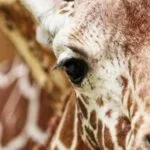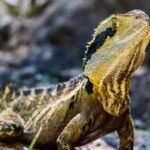What Goes In, Must Come Out: Animal Welfare Inputs and Outputs
In the previous editions of our Lessons In Welfare blog series, we started to unpack the nuances of animal welfare and how it can be achieved within zoos, aquariums, sanctuaries and rescue centres. This included giving animals more choice and control over their lives and providing physical and psychological comfort, as well as identifying the differences between animal husbandry and animal welfare . Now we will explore this further by delving deeper into animal welfare inputs (the care provided to the animals) and outputs (the animals response to that care), because understanding the difference between welfare inputs and outputs is crucial. These two facets form the backbone of ensuring animals not only survive but thrive in captive environments.
 Captive wild animal facilities have a duty of care towards animals and must provide a net gain of positive welfare experiences for their animals. In the Care and Welfare: What is the Difference blog, we started to tease apart what animal care staff provide for the animals and how the animals respond to this care. This is an important distinction to make, but for appropriate care to be provided, and for animals to experience positive welfare, a captive wild animal facility must have a structure that creates a culture where all staff, from directors to animal care teams, understand the distinction between what we will refer to as inputs and outputs. This is also true for accreditation or certification of facilities, and how inputs and outputs influence animal welfare during audits or evaluations of zoos, aquariums or sanctuaries.
Captive wild animal facilities have a duty of care towards animals and must provide a net gain of positive welfare experiences for their animals. In the Care and Welfare: What is the Difference blog, we started to tease apart what animal care staff provide for the animals and how the animals respond to this care. This is an important distinction to make, but for appropriate care to be provided, and for animals to experience positive welfare, a captive wild animal facility must have a structure that creates a culture where all staff, from directors to animal care teams, understand the distinction between what we will refer to as inputs and outputs. This is also true for accreditation or certification of facilities, and how inputs and outputs influence animal welfare during audits or evaluations of zoos, aquariums or sanctuaries.
Inputs: The Foundations of Welfare

Input: Staff at Melaka Zoo building a primate climbing frame.
Inputs are the resources, conditions, and management strategies employed to ensure animals’ physical and psychological needs are met. Captive facility staff have control over all aspects of the animal’s lives. This control is the input and what we put in and how we process this input can be referenced by using the 5 Domains model of animal welfare compromise. The inputs described below are the four physical or functional domains. These include:
Environment
The environment an animal lives in is created by humans. If we create an environment which encourages natural and normal behaviours for that species or individual, we start to meet the welfare needs of that animal. Our input is us creating an environment which is;

Output: Monitoring Rhino’s use of zoo enrichment.
Naturalistic: Mimicking an animal’s natural habitat aids in promoting instinctual behaviours. It is also important to have appropriate climates, such as temperature, light levels, and humidity, for that species. For instance, providing climbing structures for arboreal primates or appropriate water quality for fish.
Spacious: Ensuring animals have sufficient room to roam, play, and retreat is fundamental. Overcrowded or confined spaces can lead to stress and behavioural issues.
Refuge and Shelter: Giving animal shelter from weather conditions and opportunities to retreat from other animals or people can make them feel safe and secure. Having multiple choices of shelter or refuge gives them more options and control over how they interact with the environment humans have created.
Nutrition
 Humans provide all the food and water an animal needs. Even if we plant trees or shrubs in an exhibit or create grazing opportunities, it is the choice of the staff which plants to put into the exhibit or how much space is allocated to grass and how it is managed and maintained. There may be pools of water in an exhibit, but again, this is often created by the facility and the water quality is in human control. The animals may choose to browse or graze on the plants or drink from pools, and this can encourage choice and control over their environment, but we still need to manage this input by offering;
Humans provide all the food and water an animal needs. Even if we plant trees or shrubs in an exhibit or create grazing opportunities, it is the choice of the staff which plants to put into the exhibit or how much space is allocated to grass and how it is managed and maintained. There may be pools of water in an exhibit, but again, this is often created by the facility and the water quality is in human control. The animals may choose to browse or graze on the plants or drink from pools, and this can encourage choice and control over their environment, but we still need to manage this input by offering;
Balanced Diets: Tailoring diets to meet species-specific nutritional needs, ensuring physical health. For example, herbivores require a diet rich in fibre, while carnivores need protein-rich meals.
Feeding Enrichment: Using techniques like scatter feeding or puzzle feeders stimulates foraging behaviours, preventing boredom. By providing foods in a natural way we can encourage natural or normal behaviours, such as browse for giraffes or carcasses to carnivores.
Appropriate water or hydration: By providing water in a species appropriate way that can be accessed by all individuals, even providing multiple hydration points in an exhibit, is important to ensure all animals have access to water. Even if the animals choose to drink from a natural pool, clean and accessible water sources must be provided. For example, a desert antelope may gain much of its hydration from its diet, but we must provide it with clean water every day, so it has the choice to drink.
Health

Elephant foot care and pedicure
The healthcare provided to the animals in another input we must provide for the animals in our care. In order to provide effective healthcare for the captive animals we must carry out;
Regular Check-Ups: Routine health assessments catch potential issues early. By recording observations and sharing these records with our colleagues and veterinary teams we can respond to changes in the animals and also have a record of changes which can be monitored over time. For example, by recording environmental parameters, such as temperature, humidity, and UV, in a reptile exhibit and the behaviour of the reptiles, the staff and vets can see if these parameters are meeting the physical and psychological requirements for that species and if there are any medical issues caused by environmental stressors.
Preventative Care: Vaccinations, parasite control, and dental care are essential components. This input is important as it not only keeps the animals healthier and can improve their welfare, but it can also mean that more invasive and expensive medical procedures can be avoided.
Behavioural
 The distinction in this input is important to make. This is about the behavioural opportunities we can provide for the animals. This is an input provided by offering individuals or groups of animals environmental and behavioural enrichment which encourages natural and normal behaviours. If we create these opportunities, this input will encourage;
The distinction in this input is important to make. This is about the behavioural opportunities we can provide for the animals. This is an input provided by offering individuals or groups of animals environmental and behavioural enrichment which encourages natural and normal behaviours. If we create these opportunities, this input will encourage;
Play: Providing toys, puzzles, and varied activities keeps animals engaged, provides cognitive challenges and can reduce stereotypic behaviours.
Social Interactions: Recognising whether a species is solitary or social is vital. Social animals benefit from group interactions, while solitary species require spaces to retreat. We also have control over whether animals reproduce or not. Where breeding occurs, it must be managed effectively to ensure genetic diversity, prevent inbreeding depression, and encourage appropriate social behaviours if the exhibit has the space or infrastructure to cope with a growing population.
Environmental: As mentioned previously, if a species-specific environment is provided, the animals have an opportunity to engage in appropriate and positive behaviours. We need to focus on highly motivated behaviours (the behaviours they have adapted to undertake in nature and are often dependent on their survival, such as foraging for food, territorial marking and displays, locomotion, social interaction, refuge, resting or sleeping).
Appropriate Human Interactions: This can be how staff interact with the animals in their care or how visitors to facilities interact with the animals. If we are using positive reinforcement training (PRT), this gives animals control over whether they engage in the activity or not. Our input is rewarding the animal for interacting with us. If we have free contact with the animals or are handling them for either medical procedures or visitor interactions, we must be aware that our input is us exerting control over the animals and their choice to engage in the activity is limited. This can lead to negative outcomes e.g. fear or aggression.
Outputs: Measuring Welfare Outcomes
Outputs are the observable results stemming from the inputs, reflecting the actual welfare state of the animals. The distinction from inputs to outputs is how the animal responds to those inputs. The better the inputs and the more options and choices the animals are provided, the better the outputs or welfare outcomes for the animals will be. These include:
Behavioural Indicators
By recording positive behavioural activities such as foraging, playing, and socialising, we can evidence activities which are indicative of good welfare. Giving animals the opportunity to express positive behaviours which can be highly motivated and would increase survival in the wild provides highly rewarding experiences for those animals
If the inputs are of a low quality, this can lead the animal to become frustrated or stressed as they are not able to engage in those positive behaviours. Negative outputs from the animals can be repetitive actions like pacing or over-grooming and can signal stress, or the inability to cope with their current environment. This indicates that the inputs we are providing are not meeting the animal’s needs.
Physical Health Metrics
 By monitoring and recording physical measurement, such as weight, coat/scale/feather/beak/claw quality, and muscle tone or Body Score Condition (BSC) we are able to compare the results of our inputs which are direct indicators and outputs or outcomes for the animals.
By monitoring and recording physical measurement, such as weight, coat/scale/feather/beak/claw quality, and muscle tone or Body Score Condition (BSC) we are able to compare the results of our inputs which are direct indicators and outputs or outcomes for the animals.
If we are providing proactive healthcare and monitoring the environment provided to the animals, we are more likely to see lower instances of illness which suggest effective health care. Conversely, if the outputs for the animals show an increase in poor health, we can infer that the inputs are inadequate and corrective action must be taken.
The Interplay Between Inputs and Outputs
The relationship between inputs and outputs is dynamic. High-quality inputs should, in theory, lead to positive outputs. For example, providing a diverse and engaging habitat (input) should result in naturalistic behaviours and reduced stress indicators (outputs).
However, discrepancies can arise. An enclosure might meet all spatial and enrichment standards, yet an animal might still exhibit stress behaviours due to factors like past trauma or social incompatibilities. Hence, continuous monitoring and adjustments are paramount. By recording and evaluating our inputs and the animal’s outputs we can build a picture of what the animal needs by adapting our inputs and monitoring the resulting outputs. It is also important to remember that inputs are not measured independently. Good nutrition or healthcare does not negate a poor environment. Likewise, breeding and longevity are not good standalone output indicators, we must take into account the behaviours of the species and the individuals. When monitoring and recording outputs remember that behaviour is always meaningful, whether positive or negative, and we must react accordingly by reviewing our inputs.
Ensuring animal welfare in captive facilities is a meticulous balance between providing optimal conditions (inputs) and continuously assessing the resultant well-being (outputs). By understanding and monitoring this relationship, zoos, aquariums, sanctuaries and rescue centres can create environments and an infrastructure where animals can thrive, not just survive.
As our understanding of animal needs deepens, so too must our commitment to refining both the inputs we provide and the outputs we monitor. Through this continuous journey, we uphold the responsibility of offering the best possible care to the animals entrusted to us.
To explore animal welfare in more depth, check out our animal welfare page or our free to access online learning programme.
You can help Wild Welfare improve the lives of captive animals by supporting our efforts. Share this article, sign up to our newsletter, follow our social media accounts (Facebook, Instagram, Twitter/X), or make a donation. As little as £5 can help us develop accessible animal resources. As a small charity we are reliant upon the generosity of those who are passionate about improving captive wild animal’s lives. Please consider donating here.





